Case Study: Legal and Professional Issues in End-of-Life Nursing Care
VerifiedAdded on 2021/05/31
|11
|2861
|21
Case Study
AI Summary
This case study examines the complex legal and ethical issues encountered in palliative care, focusing on a patient named Tom. The scenario highlights the importance of shared decision-making, especially when dealing with patients' end-of-life care and the involvement of family members with power of attorney or enduring guardianship. The case explores conflicts arising from differing legal authorities and the significance of advance care planning. It delves into the use of medications like morphine for pain management, addressing potential clinical issues such as overdose and drowsiness, while also emphasizing the need for effective communication with both the patient and family. Furthermore, the case underscores the importance of culturally appropriate care, particularly for Aboriginal and Torres Strait Islander peoples, emphasizing the need for holistic approaches that respect cultural and spiritual beliefs to ensure the best possible care. The case study concludes by emphasizing the need to resolve all ethical and legal complications to improve the patient's health outcome.
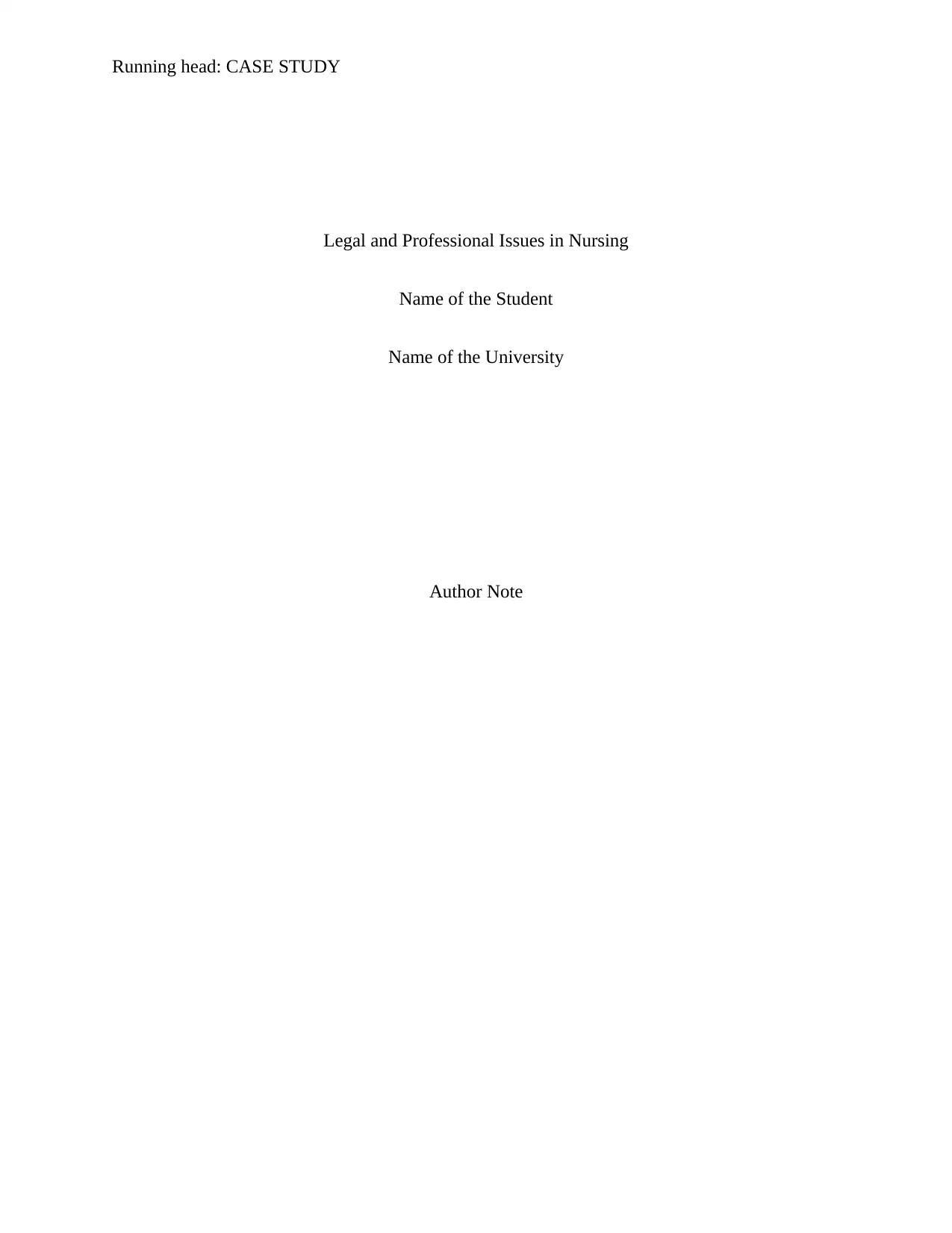
Running head: CASE STUDY
Legal and Professional Issues in Nursing
Name of the Student
Name of the University
Author Note
Legal and Professional Issues in Nursing
Name of the Student
Name of the University
Author Note
Paraphrase This Document
Need a fresh take? Get an instant paraphrase of this document with our AI Paraphraser
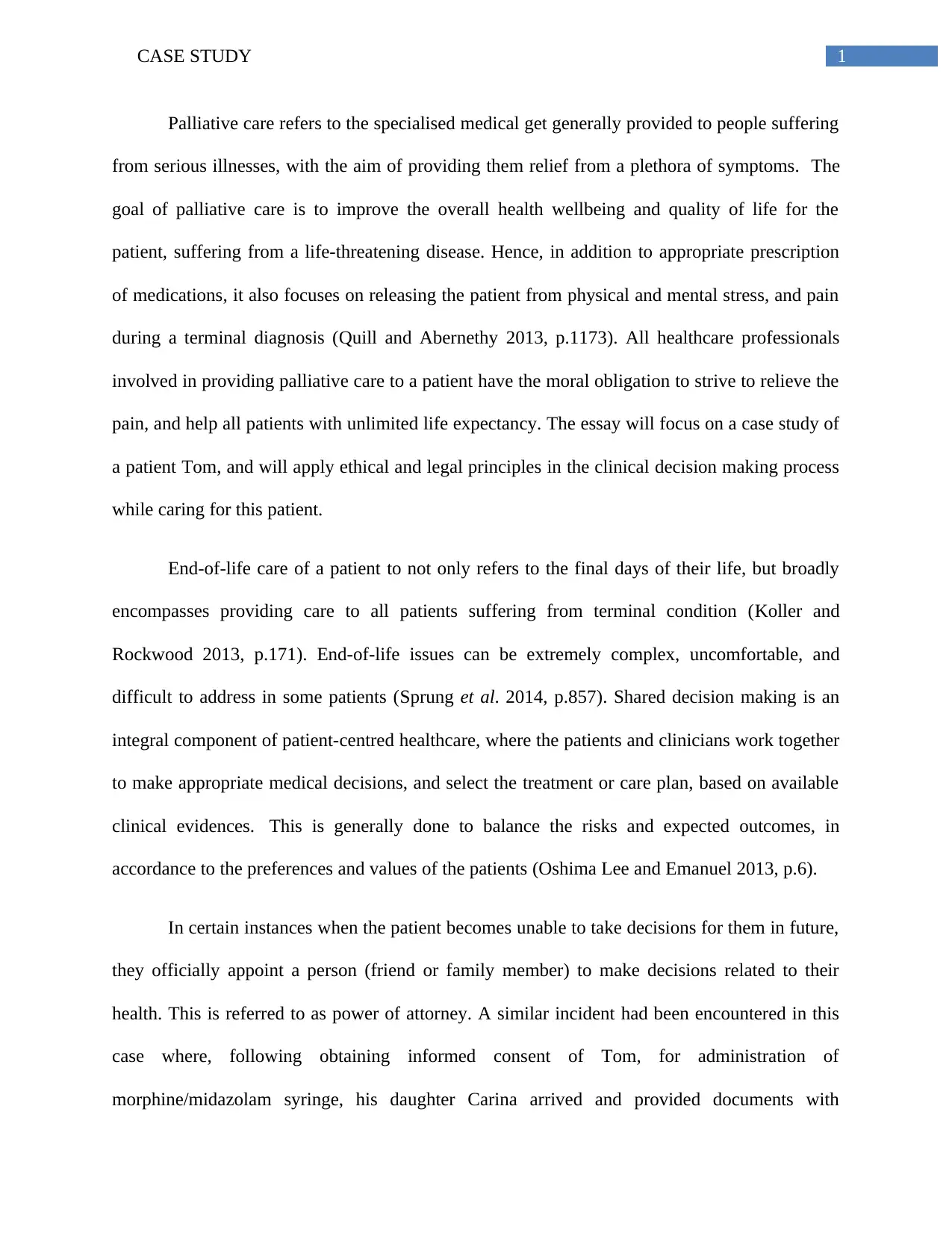
1CASE STUDY
Palliative care refers to the specialised medical get generally provided to people suffering
from serious illnesses, with the aim of providing them relief from a plethora of symptoms. The
goal of palliative care is to improve the overall health wellbeing and quality of life for the
patient, suffering from a life-threatening disease. Hence, in addition to appropriate prescription
of medications, it also focuses on releasing the patient from physical and mental stress, and pain
during a terminal diagnosis (Quill and Abernethy 2013, p.1173). All healthcare professionals
involved in providing palliative care to a patient have the moral obligation to strive to relieve the
pain, and help all patients with unlimited life expectancy. The essay will focus on a case study of
a patient Tom, and will apply ethical and legal principles in the clinical decision making process
while caring for this patient.
End-of-life care of a patient to not only refers to the final days of their life, but broadly
encompasses providing care to all patients suffering from terminal condition (Koller and
Rockwood 2013, p.171). End-of-life issues can be extremely complex, uncomfortable, and
difficult to address in some patients (Sprung et al. 2014, p.857). Shared decision making is an
integral component of patient-centred healthcare, where the patients and clinicians work together
to make appropriate medical decisions, and select the treatment or care plan, based on available
clinical evidences. This is generally done to balance the risks and expected outcomes, in
accordance to the preferences and values of the patients (Oshima Lee and Emanuel 2013, p.6).
In certain instances when the patient becomes unable to take decisions for them in future,
they officially appoint a person (friend or family member) to make decisions related to their
health. This is referred to as power of attorney. A similar incident had been encountered in this
case where, following obtaining informed consent of Tom, for administration of
morphine/midazolam syringe, his daughter Carina arrived and provided documents with
Palliative care refers to the specialised medical get generally provided to people suffering
from serious illnesses, with the aim of providing them relief from a plethora of symptoms. The
goal of palliative care is to improve the overall health wellbeing and quality of life for the
patient, suffering from a life-threatening disease. Hence, in addition to appropriate prescription
of medications, it also focuses on releasing the patient from physical and mental stress, and pain
during a terminal diagnosis (Quill and Abernethy 2013, p.1173). All healthcare professionals
involved in providing palliative care to a patient have the moral obligation to strive to relieve the
pain, and help all patients with unlimited life expectancy. The essay will focus on a case study of
a patient Tom, and will apply ethical and legal principles in the clinical decision making process
while caring for this patient.
End-of-life care of a patient to not only refers to the final days of their life, but broadly
encompasses providing care to all patients suffering from terminal condition (Koller and
Rockwood 2013, p.171). End-of-life issues can be extremely complex, uncomfortable, and
difficult to address in some patients (Sprung et al. 2014, p.857). Shared decision making is an
integral component of patient-centred healthcare, where the patients and clinicians work together
to make appropriate medical decisions, and select the treatment or care plan, based on available
clinical evidences. This is generally done to balance the risks and expected outcomes, in
accordance to the preferences and values of the patients (Oshima Lee and Emanuel 2013, p.6).
In certain instances when the patient becomes unable to take decisions for them in future,
they officially appoint a person (friend or family member) to make decisions related to their
health. This is referred to as power of attorney. A similar incident had been encountered in this
case where, following obtaining informed consent of Tom, for administration of
morphine/midazolam syringe, his daughter Carina arrived and provided documents with
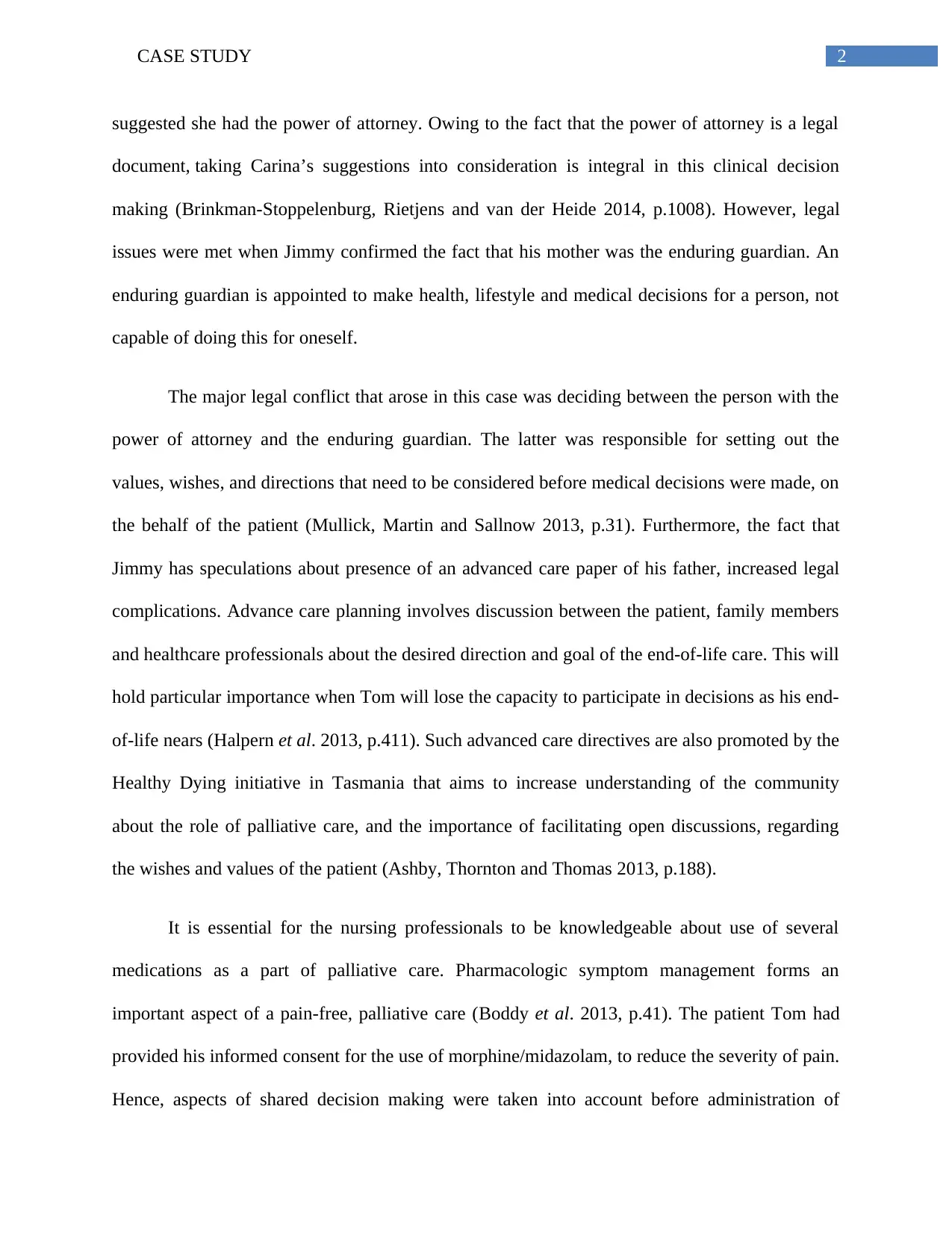
2CASE STUDY
suggested she had the power of attorney. Owing to the fact that the power of attorney is a legal
document, taking Carina’s suggestions into consideration is integral in this clinical decision
making (Brinkman-Stoppelenburg, Rietjens and van der Heide 2014, p.1008). However, legal
issues were met when Jimmy confirmed the fact that his mother was the enduring guardian. An
enduring guardian is appointed to make health, lifestyle and medical decisions for a person, not
capable of doing this for oneself.
The major legal conflict that arose in this case was deciding between the person with the
power of attorney and the enduring guardian. The latter was responsible for setting out the
values, wishes, and directions that need to be considered before medical decisions were made, on
the behalf of the patient (Mullick, Martin and Sallnow 2013, p.31). Furthermore, the fact that
Jimmy has speculations about presence of an advanced care paper of his father, increased legal
complications. Advance care planning involves discussion between the patient, family members
and healthcare professionals about the desired direction and goal of the end-of-life care. This will
hold particular importance when Tom will lose the capacity to participate in decisions as his end-
of-life nears (Halpern et al. 2013, p.411). Such advanced care directives are also promoted by the
Healthy Dying initiative in Tasmania that aims to increase understanding of the community
about the role of palliative care, and the importance of facilitating open discussions, regarding
the wishes and values of the patient (Ashby, Thornton and Thomas 2013, p.188).
It is essential for the nursing professionals to be knowledgeable about use of several
medications as a part of palliative care. Pharmacologic symptom management forms an
important aspect of a pain-free, palliative care (Boddy et al. 2013, p.41). The patient Tom had
provided his informed consent for the use of morphine/midazolam, to reduce the severity of pain.
Hence, aspects of shared decision making were taken into account before administration of
suggested she had the power of attorney. Owing to the fact that the power of attorney is a legal
document, taking Carina’s suggestions into consideration is integral in this clinical decision
making (Brinkman-Stoppelenburg, Rietjens and van der Heide 2014, p.1008). However, legal
issues were met when Jimmy confirmed the fact that his mother was the enduring guardian. An
enduring guardian is appointed to make health, lifestyle and medical decisions for a person, not
capable of doing this for oneself.
The major legal conflict that arose in this case was deciding between the person with the
power of attorney and the enduring guardian. The latter was responsible for setting out the
values, wishes, and directions that need to be considered before medical decisions were made, on
the behalf of the patient (Mullick, Martin and Sallnow 2013, p.31). Furthermore, the fact that
Jimmy has speculations about presence of an advanced care paper of his father, increased legal
complications. Advance care planning involves discussion between the patient, family members
and healthcare professionals about the desired direction and goal of the end-of-life care. This will
hold particular importance when Tom will lose the capacity to participate in decisions as his end-
of-life nears (Halpern et al. 2013, p.411). Such advanced care directives are also promoted by the
Healthy Dying initiative in Tasmania that aims to increase understanding of the community
about the role of palliative care, and the importance of facilitating open discussions, regarding
the wishes and values of the patient (Ashby, Thornton and Thomas 2013, p.188).
It is essential for the nursing professionals to be knowledgeable about use of several
medications as a part of palliative care. Pharmacologic symptom management forms an
important aspect of a pain-free, palliative care (Boddy et al. 2013, p.41). The patient Tom had
provided his informed consent for the use of morphine/midazolam, to reduce the severity of pain.
Hence, aspects of shared decision making were taken into account before administration of
⊘ This is a preview!⊘
Do you want full access?
Subscribe today to unlock all pages.

Trusted by 1+ million students worldwide
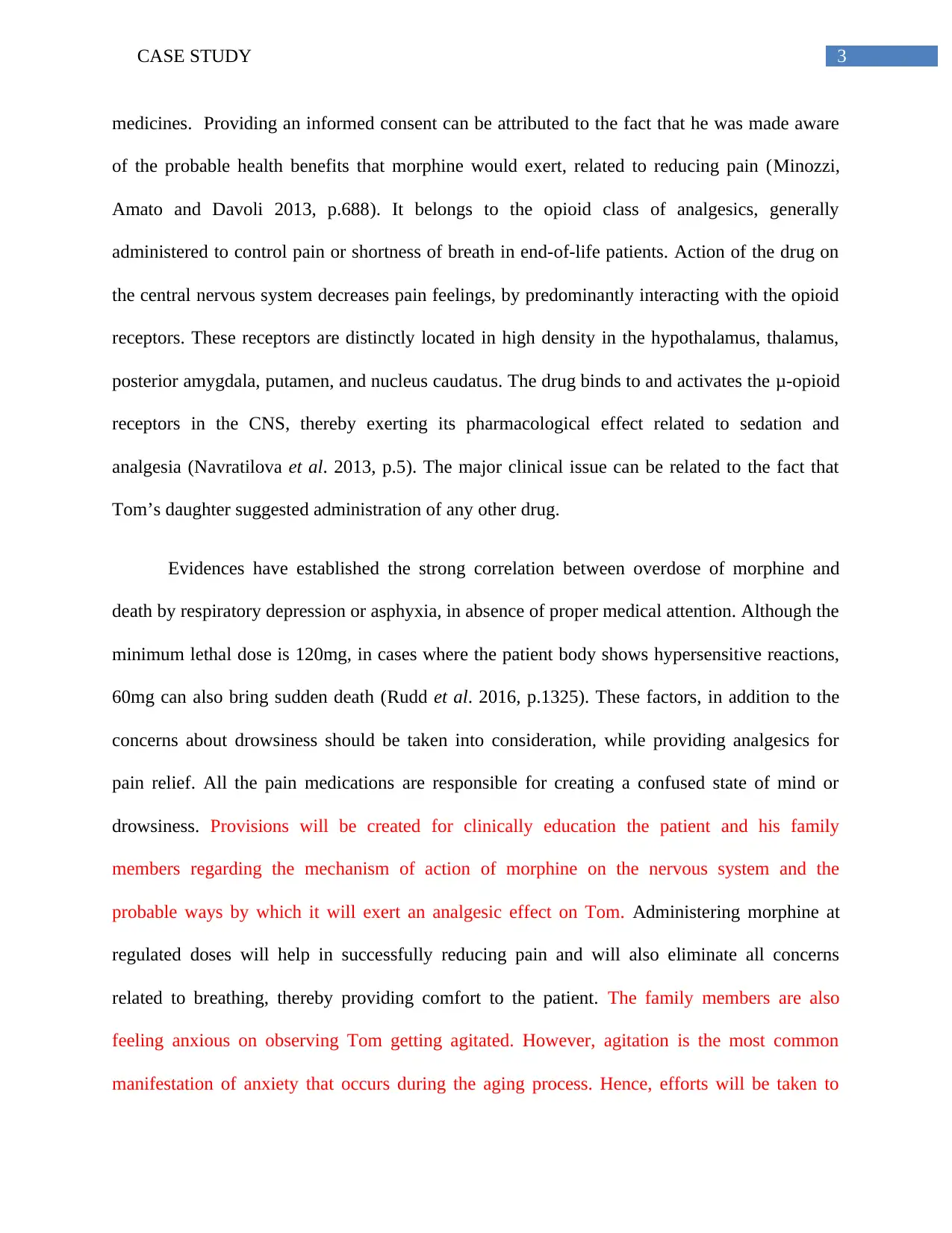
3CASE STUDY
medicines. Providing an informed consent can be attributed to the fact that he was made aware
of the probable health benefits that morphine would exert, related to reducing pain (Minozzi,
Amato and Davoli 2013, p.688). It belongs to the opioid class of analgesics, generally
administered to control pain or shortness of breath in end-of-life patients. Action of the drug on
the central nervous system decreases pain feelings, by predominantly interacting with the opioid
receptors. These receptors are distinctly located in high density in the hypothalamus, thalamus,
posterior amygdala, putamen, and nucleus caudatus. The drug binds to and activates the μ-opioid
receptors in the CNS, thereby exerting its pharmacological effect related to sedation and
analgesia (Navratilova et al. 2013, p.5). The major clinical issue can be related to the fact that
Tom’s daughter suggested administration of any other drug.
Evidences have established the strong correlation between overdose of morphine and
death by respiratory depression or asphyxia, in absence of proper medical attention. Although the
minimum lethal dose is 120mg, in cases where the patient body shows hypersensitive reactions,
60mg can also bring sudden death (Rudd et al. 2016, p.1325). These factors, in addition to the
concerns about drowsiness should be taken into consideration, while providing analgesics for
pain relief. All the pain medications are responsible for creating a confused state of mind or
drowsiness. Provisions will be created for clinically education the patient and his family
members regarding the mechanism of action of morphine on the nervous system and the
probable ways by which it will exert an analgesic effect on Tom. Administering morphine at
regulated doses will help in successfully reducing pain and will also eliminate all concerns
related to breathing, thereby providing comfort to the patient. The family members are also
feeling anxious on observing Tom getting agitated. However, agitation is the most common
manifestation of anxiety that occurs during the aging process. Hence, efforts will be taken to
medicines. Providing an informed consent can be attributed to the fact that he was made aware
of the probable health benefits that morphine would exert, related to reducing pain (Minozzi,
Amato and Davoli 2013, p.688). It belongs to the opioid class of analgesics, generally
administered to control pain or shortness of breath in end-of-life patients. Action of the drug on
the central nervous system decreases pain feelings, by predominantly interacting with the opioid
receptors. These receptors are distinctly located in high density in the hypothalamus, thalamus,
posterior amygdala, putamen, and nucleus caudatus. The drug binds to and activates the μ-opioid
receptors in the CNS, thereby exerting its pharmacological effect related to sedation and
analgesia (Navratilova et al. 2013, p.5). The major clinical issue can be related to the fact that
Tom’s daughter suggested administration of any other drug.
Evidences have established the strong correlation between overdose of morphine and
death by respiratory depression or asphyxia, in absence of proper medical attention. Although the
minimum lethal dose is 120mg, in cases where the patient body shows hypersensitive reactions,
60mg can also bring sudden death (Rudd et al. 2016, p.1325). These factors, in addition to the
concerns about drowsiness should be taken into consideration, while providing analgesics for
pain relief. All the pain medications are responsible for creating a confused state of mind or
drowsiness. Provisions will be created for clinically education the patient and his family
members regarding the mechanism of action of morphine on the nervous system and the
probable ways by which it will exert an analgesic effect on Tom. Administering morphine at
regulated doses will help in successfully reducing pain and will also eliminate all concerns
related to breathing, thereby providing comfort to the patient. The family members are also
feeling anxious on observing Tom getting agitated. However, agitation is the most common
manifestation of anxiety that occurs during the aging process. Hence, efforts will be taken to
Paraphrase This Document
Need a fresh take? Get an instant paraphrase of this document with our AI Paraphraser
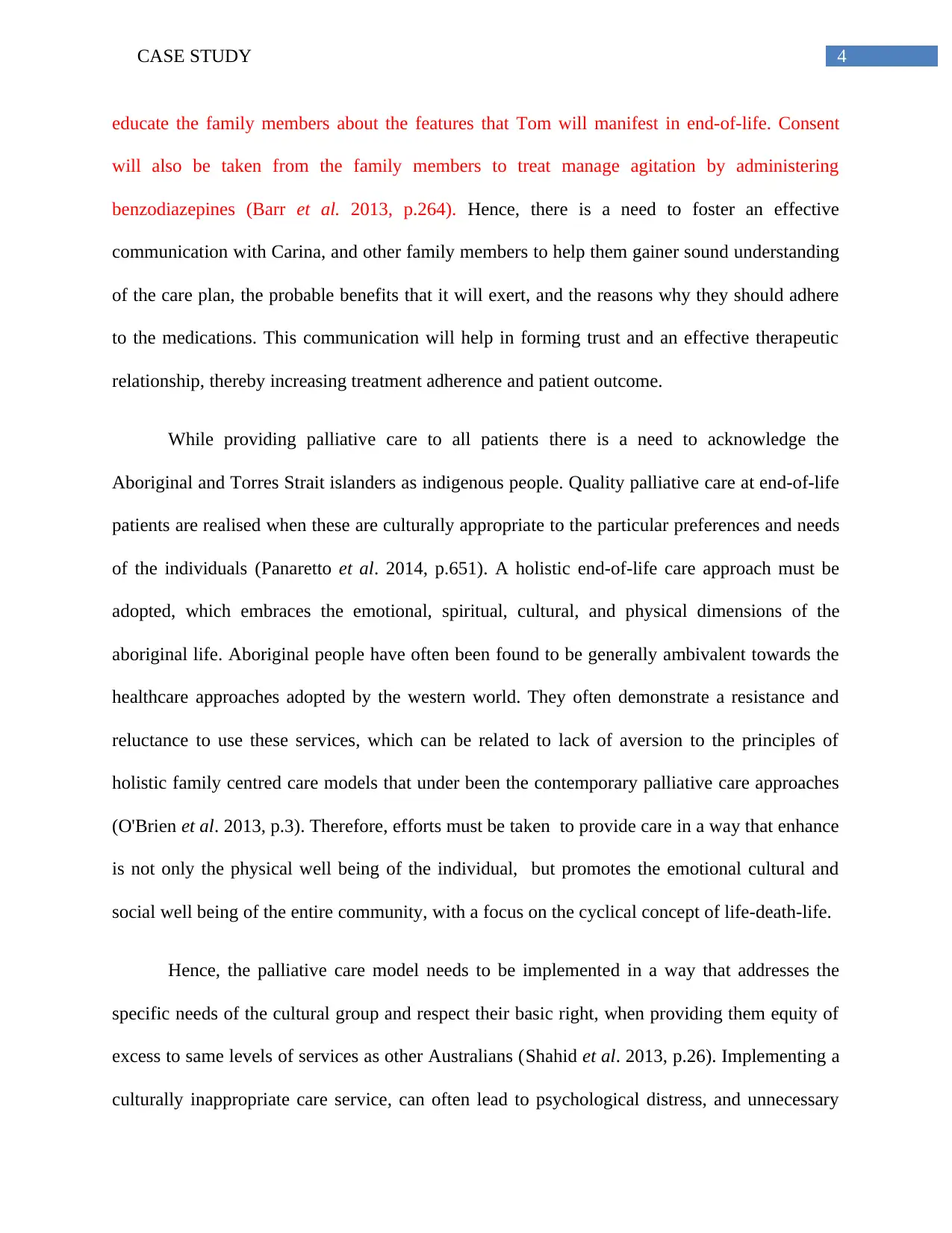
4CASE STUDY
educate the family members about the features that Tom will manifest in end-of-life. Consent
will also be taken from the family members to treat manage agitation by administering
benzodiazepines (Barr et al. 2013, p.264). Hence, there is a need to foster an effective
communication with Carina, and other family members to help them gainer sound understanding
of the care plan, the probable benefits that it will exert, and the reasons why they should adhere
to the medications. This communication will help in forming trust and an effective therapeutic
relationship, thereby increasing treatment adherence and patient outcome.
While providing palliative care to all patients there is a need to acknowledge the
Aboriginal and Torres Strait islanders as indigenous people. Quality palliative care at end-of-life
patients are realised when these are culturally appropriate to the particular preferences and needs
of the individuals (Panaretto et al. 2014, p.651). A holistic end-of-life care approach must be
adopted, which embraces the emotional, spiritual, cultural, and physical dimensions of the
aboriginal life. Aboriginal people have often been found to be generally ambivalent towards the
healthcare approaches adopted by the western world. They often demonstrate a resistance and
reluctance to use these services, which can be related to lack of aversion to the principles of
holistic family centred care models that under been the contemporary palliative care approaches
(O'Brien et al. 2013, p.3). Therefore, efforts must be taken to provide care in a way that enhance
is not only the physical well being of the individual, but promotes the emotional cultural and
social well being of the entire community, with a focus on the cyclical concept of life-death-life.
Hence, the palliative care model needs to be implemented in a way that addresses the
specific needs of the cultural group and respect their basic right, when providing them equity of
excess to same levels of services as other Australians (Shahid et al. 2013, p.26). Implementing a
culturally inappropriate care service, can often lead to psychological distress, and unnecessary
educate the family members about the features that Tom will manifest in end-of-life. Consent
will also be taken from the family members to treat manage agitation by administering
benzodiazepines (Barr et al. 2013, p.264). Hence, there is a need to foster an effective
communication with Carina, and other family members to help them gainer sound understanding
of the care plan, the probable benefits that it will exert, and the reasons why they should adhere
to the medications. This communication will help in forming trust and an effective therapeutic
relationship, thereby increasing treatment adherence and patient outcome.
While providing palliative care to all patients there is a need to acknowledge the
Aboriginal and Torres Strait islanders as indigenous people. Quality palliative care at end-of-life
patients are realised when these are culturally appropriate to the particular preferences and needs
of the individuals (Panaretto et al. 2014, p.651). A holistic end-of-life care approach must be
adopted, which embraces the emotional, spiritual, cultural, and physical dimensions of the
aboriginal life. Aboriginal people have often been found to be generally ambivalent towards the
healthcare approaches adopted by the western world. They often demonstrate a resistance and
reluctance to use these services, which can be related to lack of aversion to the principles of
holistic family centred care models that under been the contemporary palliative care approaches
(O'Brien et al. 2013, p.3). Therefore, efforts must be taken to provide care in a way that enhance
is not only the physical well being of the individual, but promotes the emotional cultural and
social well being of the entire community, with a focus on the cyclical concept of life-death-life.
Hence, the palliative care model needs to be implemented in a way that addresses the
specific needs of the cultural group and respect their basic right, when providing them equity of
excess to same levels of services as other Australians (Shahid et al. 2013, p.26). Implementing a
culturally inappropriate care service, can often lead to psychological distress, and unnecessary
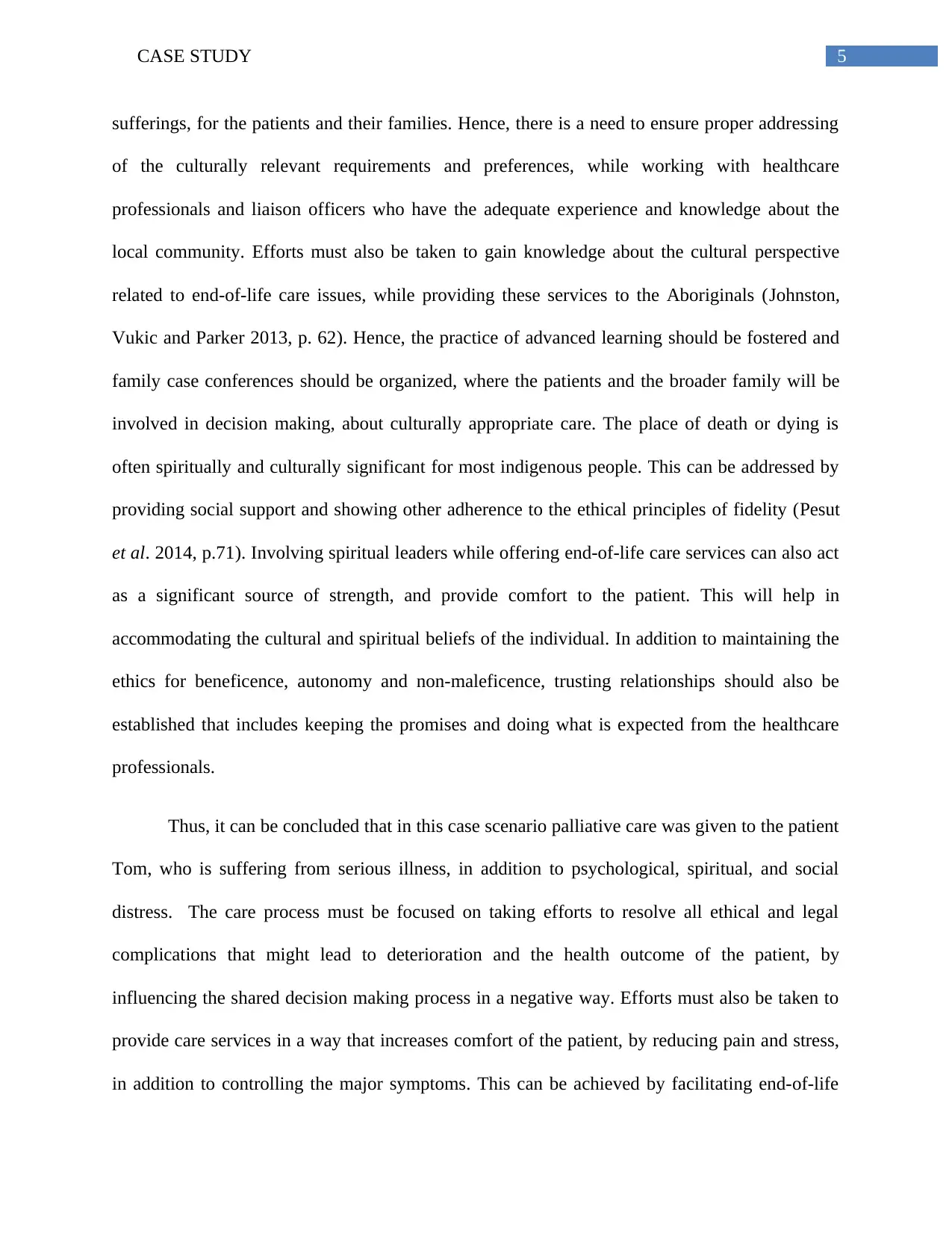
5CASE STUDY
sufferings, for the patients and their families. Hence, there is a need to ensure proper addressing
of the culturally relevant requirements and preferences, while working with healthcare
professionals and liaison officers who have the adequate experience and knowledge about the
local community. Efforts must also be taken to gain knowledge about the cultural perspective
related to end-of-life care issues, while providing these services to the Aboriginals (Johnston,
Vukic and Parker 2013, p. 62). Hence, the practice of advanced learning should be fostered and
family case conferences should be organized, where the patients and the broader family will be
involved in decision making, about culturally appropriate care. The place of death or dying is
often spiritually and culturally significant for most indigenous people. This can be addressed by
providing social support and showing other adherence to the ethical principles of fidelity (Pesut
et al. 2014, p.71). Involving spiritual leaders while offering end-of-life care services can also act
as a significant source of strength, and provide comfort to the patient. This will help in
accommodating the cultural and spiritual beliefs of the individual. In addition to maintaining the
ethics for beneficence, autonomy and non-maleficence, trusting relationships should also be
established that includes keeping the promises and doing what is expected from the healthcare
professionals.
Thus, it can be concluded that in this case scenario palliative care was given to the patient
Tom, who is suffering from serious illness, in addition to psychological, spiritual, and social
distress. The care process must be focused on taking efforts to resolve all ethical and legal
complications that might lead to deterioration and the health outcome of the patient, by
influencing the shared decision making process in a negative way. Efforts must also be taken to
provide care services in a way that increases comfort of the patient, by reducing pain and stress,
in addition to controlling the major symptoms. This can be achieved by facilitating end-of-life
sufferings, for the patients and their families. Hence, there is a need to ensure proper addressing
of the culturally relevant requirements and preferences, while working with healthcare
professionals and liaison officers who have the adequate experience and knowledge about the
local community. Efforts must also be taken to gain knowledge about the cultural perspective
related to end-of-life care issues, while providing these services to the Aboriginals (Johnston,
Vukic and Parker 2013, p. 62). Hence, the practice of advanced learning should be fostered and
family case conferences should be organized, where the patients and the broader family will be
involved in decision making, about culturally appropriate care. The place of death or dying is
often spiritually and culturally significant for most indigenous people. This can be addressed by
providing social support and showing other adherence to the ethical principles of fidelity (Pesut
et al. 2014, p.71). Involving spiritual leaders while offering end-of-life care services can also act
as a significant source of strength, and provide comfort to the patient. This will help in
accommodating the cultural and spiritual beliefs of the individual. In addition to maintaining the
ethics for beneficence, autonomy and non-maleficence, trusting relationships should also be
established that includes keeping the promises and doing what is expected from the healthcare
professionals.
Thus, it can be concluded that in this case scenario palliative care was given to the patient
Tom, who is suffering from serious illness, in addition to psychological, spiritual, and social
distress. The care process must be focused on taking efforts to resolve all ethical and legal
complications that might lead to deterioration and the health outcome of the patient, by
influencing the shared decision making process in a negative way. Efforts must also be taken to
provide care services in a way that increases comfort of the patient, by reducing pain and stress,
in addition to controlling the major symptoms. This can be achieved by facilitating end-of-life
⊘ This is a preview!⊘
Do you want full access?
Subscribe today to unlock all pages.

Trusted by 1+ million students worldwide
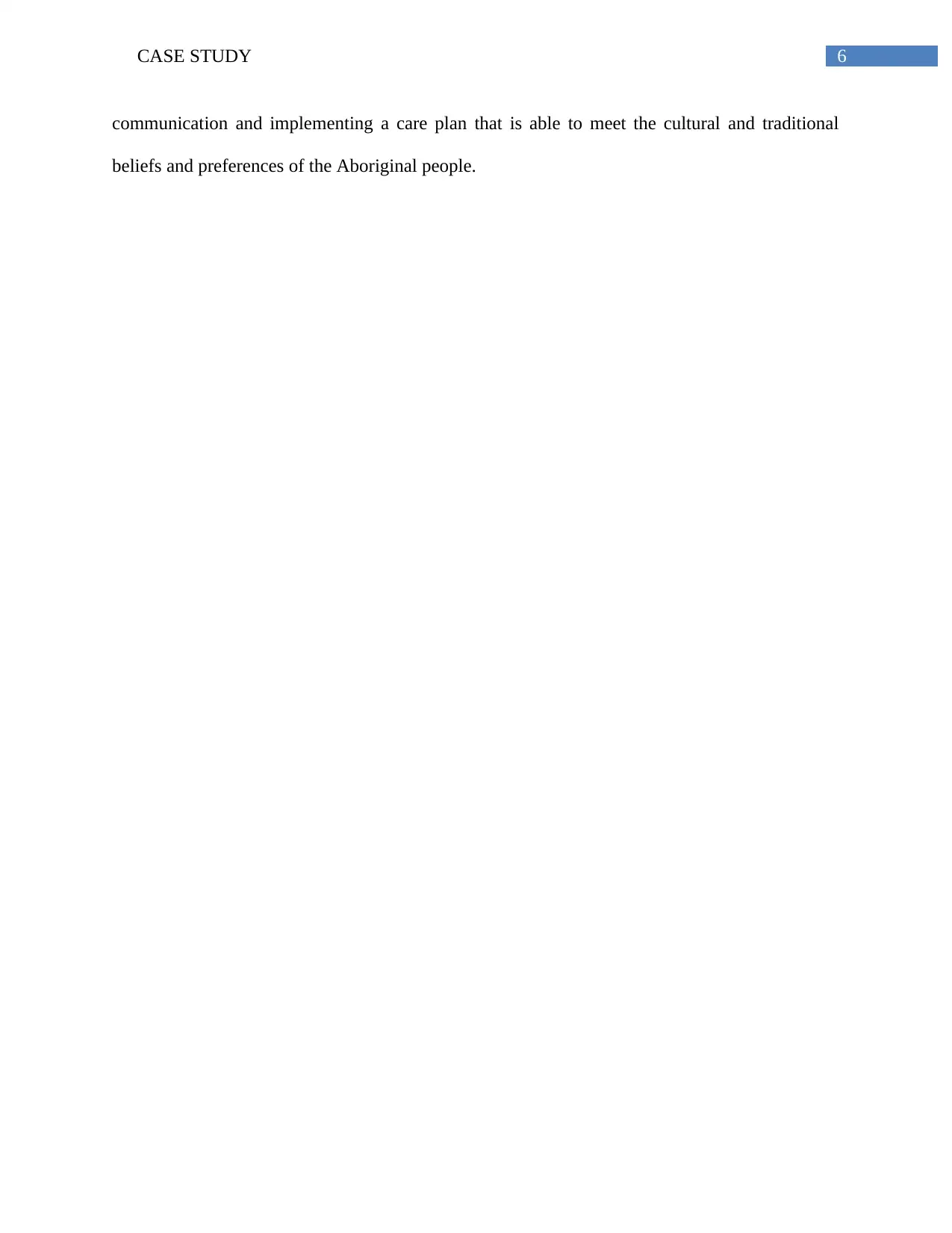
6CASE STUDY
communication and implementing a care plan that is able to meet the cultural and traditional
beliefs and preferences of the Aboriginal people.
communication and implementing a care plan that is able to meet the cultural and traditional
beliefs and preferences of the Aboriginal people.
Paraphrase This Document
Need a fresh take? Get an instant paraphrase of this document with our AI Paraphraser
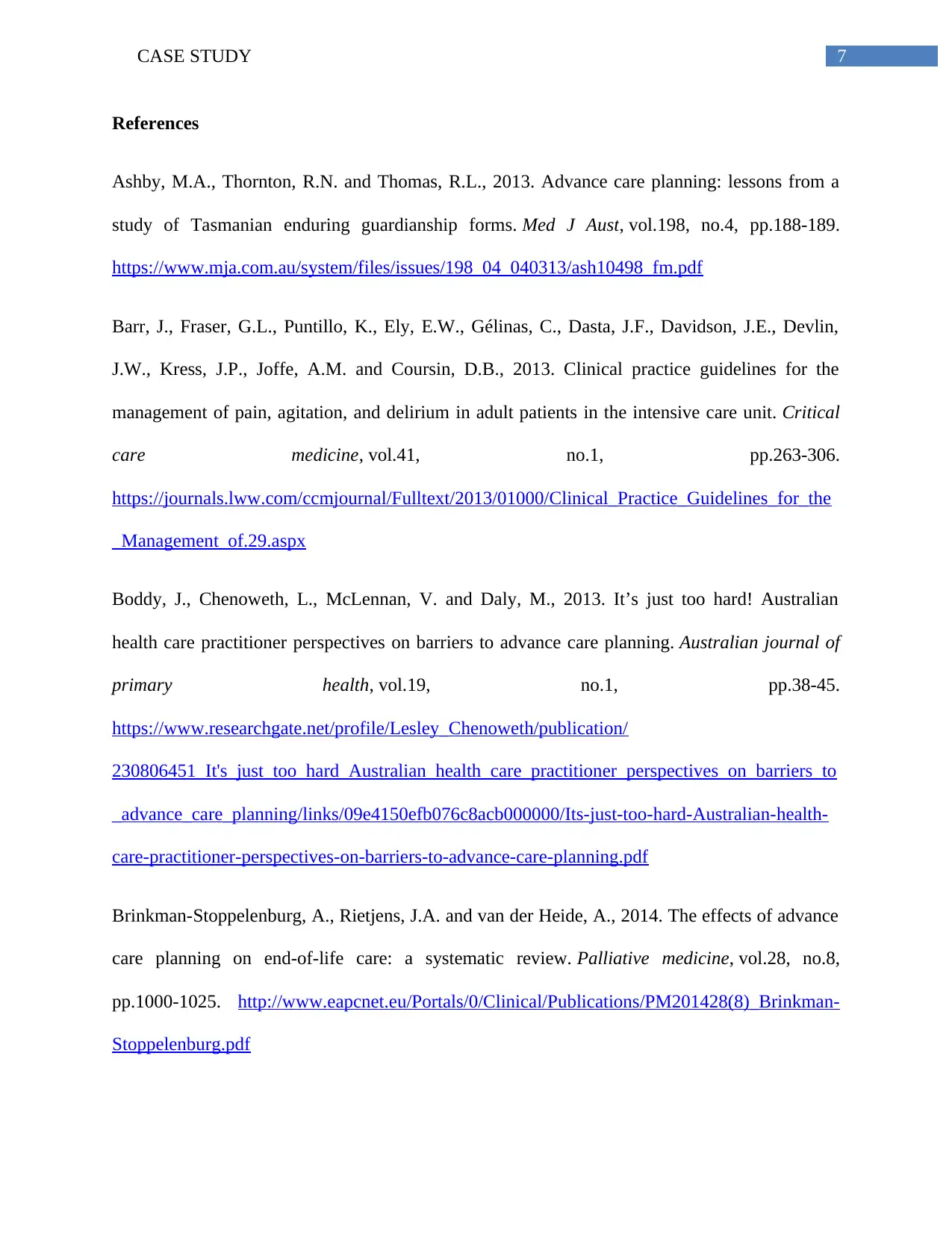
7CASE STUDY
References
Ashby, M.A., Thornton, R.N. and Thomas, R.L., 2013. Advance care planning: lessons from a
study of Tasmanian enduring guardianship forms. Med J Aust, vol.198, no.4, pp.188-189.
https://www.mja.com.au/system/files/issues/198_04_040313/ash10498_fm.pdf
Barr, J., Fraser, G.L., Puntillo, K., Ely, E.W., Gélinas, C., Dasta, J.F., Davidson, J.E., Devlin,
J.W., Kress, J.P., Joffe, A.M. and Coursin, D.B., 2013. Clinical practice guidelines for the
management of pain, agitation, and delirium in adult patients in the intensive care unit. Critical
care medicine, vol.41, no.1, pp.263-306.
https://journals.lww.com/ccmjournal/Fulltext/2013/01000/Clinical_Practice_Guidelines_for_the
_Management_of.29.aspx
Boddy, J., Chenoweth, L., McLennan, V. and Daly, M., 2013. It’s just too hard! Australian
health care practitioner perspectives on barriers to advance care planning. Australian journal of
primary health, vol.19, no.1, pp.38-45.
https://www.researchgate.net/profile/Lesley_Chenoweth/publication/
230806451_It's_just_too_hard_Australian_health_care_practitioner_perspectives_on_barriers_to
_advance_care_planning/links/09e4150efb076c8acb000000/Its-just-too-hard-Australian-health-
care-practitioner-perspectives-on-barriers-to-advance-care-planning.pdf
Brinkman-Stoppelenburg, A., Rietjens, J.A. and van der Heide, A., 2014. The effects of advance
care planning on end-of-life care: a systematic review. Palliative medicine, vol.28, no.8,
pp.1000-1025. http://www.eapcnet.eu/Portals/0/Clinical/Publications/PM201428(8)_Brinkman-
Stoppelenburg.pdf
References
Ashby, M.A., Thornton, R.N. and Thomas, R.L., 2013. Advance care planning: lessons from a
study of Tasmanian enduring guardianship forms. Med J Aust, vol.198, no.4, pp.188-189.
https://www.mja.com.au/system/files/issues/198_04_040313/ash10498_fm.pdf
Barr, J., Fraser, G.L., Puntillo, K., Ely, E.W., Gélinas, C., Dasta, J.F., Davidson, J.E., Devlin,
J.W., Kress, J.P., Joffe, A.M. and Coursin, D.B., 2013. Clinical practice guidelines for the
management of pain, agitation, and delirium in adult patients in the intensive care unit. Critical
care medicine, vol.41, no.1, pp.263-306.
https://journals.lww.com/ccmjournal/Fulltext/2013/01000/Clinical_Practice_Guidelines_for_the
_Management_of.29.aspx
Boddy, J., Chenoweth, L., McLennan, V. and Daly, M., 2013. It’s just too hard! Australian
health care practitioner perspectives on barriers to advance care planning. Australian journal of
primary health, vol.19, no.1, pp.38-45.
https://www.researchgate.net/profile/Lesley_Chenoweth/publication/
230806451_It's_just_too_hard_Australian_health_care_practitioner_perspectives_on_barriers_to
_advance_care_planning/links/09e4150efb076c8acb000000/Its-just-too-hard-Australian-health-
care-practitioner-perspectives-on-barriers-to-advance-care-planning.pdf
Brinkman-Stoppelenburg, A., Rietjens, J.A. and van der Heide, A., 2014. The effects of advance
care planning on end-of-life care: a systematic review. Palliative medicine, vol.28, no.8,
pp.1000-1025. http://www.eapcnet.eu/Portals/0/Clinical/Publications/PM201428(8)_Brinkman-
Stoppelenburg.pdf
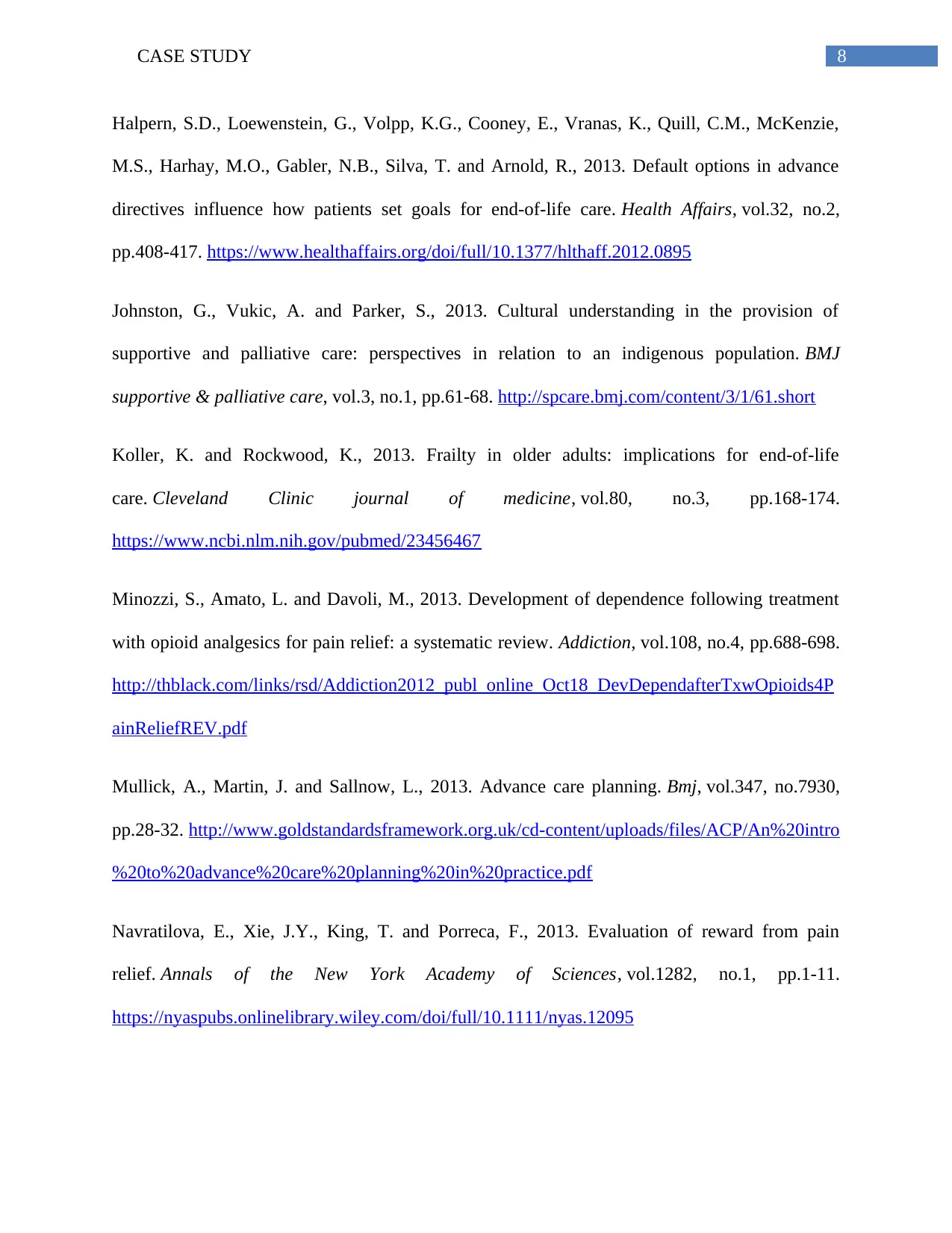
8CASE STUDY
Halpern, S.D., Loewenstein, G., Volpp, K.G., Cooney, E., Vranas, K., Quill, C.M., McKenzie,
M.S., Harhay, M.O., Gabler, N.B., Silva, T. and Arnold, R., 2013. Default options in advance
directives influence how patients set goals for end-of-life care. Health Affairs, vol.32, no.2,
pp.408-417. https://www.healthaffairs.org/doi/full/10.1377/hlthaff.2012.0895
Johnston, G., Vukic, A. and Parker, S., 2013. Cultural understanding in the provision of
supportive and palliative care: perspectives in relation to an indigenous population. BMJ
supportive & palliative care, vol.3, no.1, pp.61-68. http://spcare.bmj.com/content/3/1/61.short
Koller, K. and Rockwood, K., 2013. Frailty in older adults: implications for end-of-life
care. Cleveland Clinic journal of medicine, vol.80, no.3, pp.168-174.
https://www.ncbi.nlm.nih.gov/pubmed/23456467
Minozzi, S., Amato, L. and Davoli, M., 2013. Development of dependence following treatment
with opioid analgesics for pain relief: a systematic review. Addiction, vol.108, no.4, pp.688-698.
http://thblack.com/links/rsd/Addiction2012_publ_online_Oct18_DevDependafterTxwOpioids4P
ainReliefREV.pdf
Mullick, A., Martin, J. and Sallnow, L., 2013. Advance care planning. Bmj, vol.347, no.7930,
pp.28-32. http://www.goldstandardsframework.org.uk/cd-content/uploads/files/ACP/An%20intro
%20to%20advance%20care%20planning%20in%20practice.pdf
Navratilova, E., Xie, J.Y., King, T. and Porreca, F., 2013. Evaluation of reward from pain
relief. Annals of the New York Academy of Sciences, vol.1282, no.1, pp.1-11.
https://nyaspubs.onlinelibrary.wiley.com/doi/full/10.1111/nyas.12095
Halpern, S.D., Loewenstein, G., Volpp, K.G., Cooney, E., Vranas, K., Quill, C.M., McKenzie,
M.S., Harhay, M.O., Gabler, N.B., Silva, T. and Arnold, R., 2013. Default options in advance
directives influence how patients set goals for end-of-life care. Health Affairs, vol.32, no.2,
pp.408-417. https://www.healthaffairs.org/doi/full/10.1377/hlthaff.2012.0895
Johnston, G., Vukic, A. and Parker, S., 2013. Cultural understanding in the provision of
supportive and palliative care: perspectives in relation to an indigenous population. BMJ
supportive & palliative care, vol.3, no.1, pp.61-68. http://spcare.bmj.com/content/3/1/61.short
Koller, K. and Rockwood, K., 2013. Frailty in older adults: implications for end-of-life
care. Cleveland Clinic journal of medicine, vol.80, no.3, pp.168-174.
https://www.ncbi.nlm.nih.gov/pubmed/23456467
Minozzi, S., Amato, L. and Davoli, M., 2013. Development of dependence following treatment
with opioid analgesics for pain relief: a systematic review. Addiction, vol.108, no.4, pp.688-698.
http://thblack.com/links/rsd/Addiction2012_publ_online_Oct18_DevDependafterTxwOpioids4P
ainReliefREV.pdf
Mullick, A., Martin, J. and Sallnow, L., 2013. Advance care planning. Bmj, vol.347, no.7930,
pp.28-32. http://www.goldstandardsframework.org.uk/cd-content/uploads/files/ACP/An%20intro
%20to%20advance%20care%20planning%20in%20practice.pdf
Navratilova, E., Xie, J.Y., King, T. and Porreca, F., 2013. Evaluation of reward from pain
relief. Annals of the New York Academy of Sciences, vol.1282, no.1, pp.1-11.
https://nyaspubs.onlinelibrary.wiley.com/doi/full/10.1111/nyas.12095
⊘ This is a preview!⊘
Do you want full access?
Subscribe today to unlock all pages.

Trusted by 1+ million students worldwide
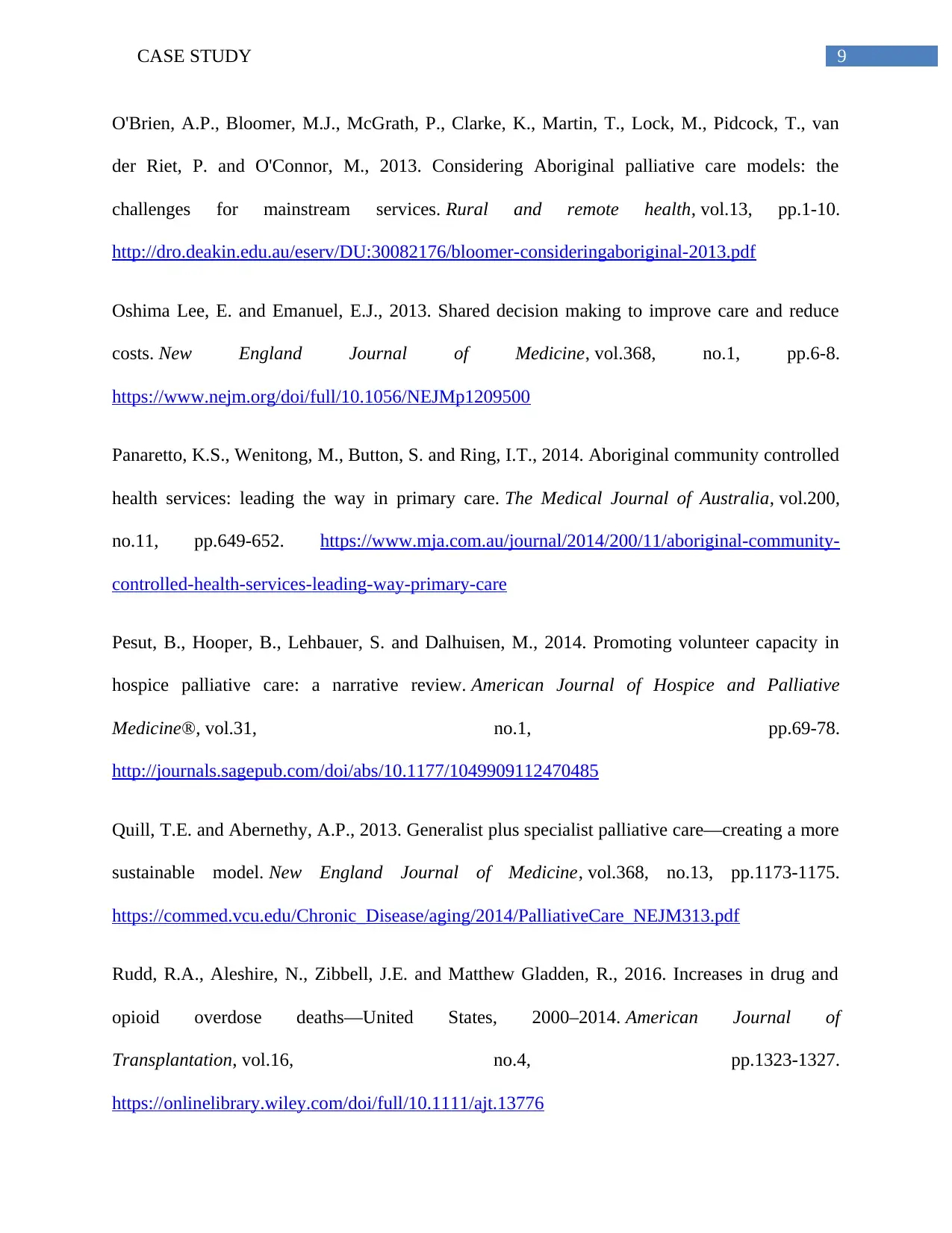
9CASE STUDY
O'Brien, A.P., Bloomer, M.J., McGrath, P., Clarke, K., Martin, T., Lock, M., Pidcock, T., van
der Riet, P. and O'Connor, M., 2013. Considering Aboriginal palliative care models: the
challenges for mainstream services. Rural and remote health, vol.13, pp.1-10.
http://dro.deakin.edu.au/eserv/DU:30082176/bloomer-consideringaboriginal-2013.pdf
Oshima Lee, E. and Emanuel, E.J., 2013. Shared decision making to improve care and reduce
costs. New England Journal of Medicine, vol.368, no.1, pp.6-8.
https://www.nejm.org/doi/full/10.1056/NEJMp1209500
Panaretto, K.S., Wenitong, M., Button, S. and Ring, I.T., 2014. Aboriginal community controlled
health services: leading the way in primary care. The Medical Journal of Australia, vol.200,
no.11, pp.649-652. https://www.mja.com.au/journal/2014/200/11/aboriginal-community-
controlled-health-services-leading-way-primary-care
Pesut, B., Hooper, B., Lehbauer, S. and Dalhuisen, M., 2014. Promoting volunteer capacity in
hospice palliative care: a narrative review. American Journal of Hospice and Palliative
Medicine®, vol.31, no.1, pp.69-78.
http://journals.sagepub.com/doi/abs/10.1177/1049909112470485
Quill, T.E. and Abernethy, A.P., 2013. Generalist plus specialist palliative care—creating a more
sustainable model. New England Journal of Medicine, vol.368, no.13, pp.1173-1175.
https://commed.vcu.edu/Chronic_Disease/aging/2014/PalliativeCare_NEJM313.pdf
Rudd, R.A., Aleshire, N., Zibbell, J.E. and Matthew Gladden, R., 2016. Increases in drug and
opioid overdose deaths—United States, 2000–2014. American Journal of
Transplantation, vol.16, no.4, pp.1323-1327.
https://onlinelibrary.wiley.com/doi/full/10.1111/ajt.13776
O'Brien, A.P., Bloomer, M.J., McGrath, P., Clarke, K., Martin, T., Lock, M., Pidcock, T., van
der Riet, P. and O'Connor, M., 2013. Considering Aboriginal palliative care models: the
challenges for mainstream services. Rural and remote health, vol.13, pp.1-10.
http://dro.deakin.edu.au/eserv/DU:30082176/bloomer-consideringaboriginal-2013.pdf
Oshima Lee, E. and Emanuel, E.J., 2013. Shared decision making to improve care and reduce
costs. New England Journal of Medicine, vol.368, no.1, pp.6-8.
https://www.nejm.org/doi/full/10.1056/NEJMp1209500
Panaretto, K.S., Wenitong, M., Button, S. and Ring, I.T., 2014. Aboriginal community controlled
health services: leading the way in primary care. The Medical Journal of Australia, vol.200,
no.11, pp.649-652. https://www.mja.com.au/journal/2014/200/11/aboriginal-community-
controlled-health-services-leading-way-primary-care
Pesut, B., Hooper, B., Lehbauer, S. and Dalhuisen, M., 2014. Promoting volunteer capacity in
hospice palliative care: a narrative review. American Journal of Hospice and Palliative
Medicine®, vol.31, no.1, pp.69-78.
http://journals.sagepub.com/doi/abs/10.1177/1049909112470485
Quill, T.E. and Abernethy, A.P., 2013. Generalist plus specialist palliative care—creating a more
sustainable model. New England Journal of Medicine, vol.368, no.13, pp.1173-1175.
https://commed.vcu.edu/Chronic_Disease/aging/2014/PalliativeCare_NEJM313.pdf
Rudd, R.A., Aleshire, N., Zibbell, J.E. and Matthew Gladden, R., 2016. Increases in drug and
opioid overdose deaths—United States, 2000–2014. American Journal of
Transplantation, vol.16, no.4, pp.1323-1327.
https://onlinelibrary.wiley.com/doi/full/10.1111/ajt.13776
Paraphrase This Document
Need a fresh take? Get an instant paraphrase of this document with our AI Paraphraser
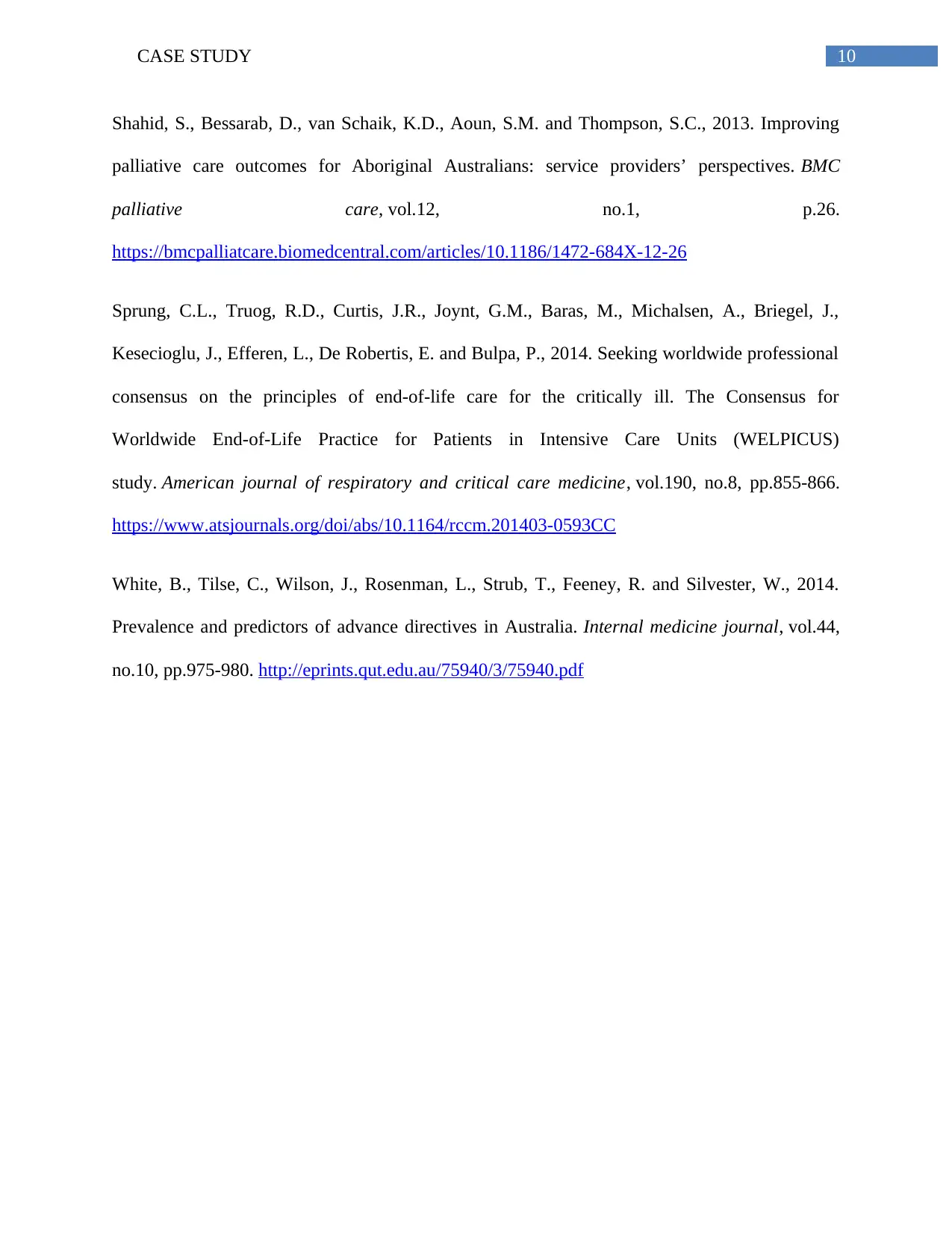
10CASE STUDY
Shahid, S., Bessarab, D., van Schaik, K.D., Aoun, S.M. and Thompson, S.C., 2013. Improving
palliative care outcomes for Aboriginal Australians: service providers’ perspectives. BMC
palliative care, vol.12, no.1, p.26.
https://bmcpalliatcare.biomedcentral.com/articles/10.1186/1472-684X-12-26
Sprung, C.L., Truog, R.D., Curtis, J.R., Joynt, G.M., Baras, M., Michalsen, A., Briegel, J.,
Kesecioglu, J., Efferen, L., De Robertis, E. and Bulpa, P., 2014. Seeking worldwide professional
consensus on the principles of end-of-life care for the critically ill. The Consensus for
Worldwide End-of-Life Practice for Patients in Intensive Care Units (WELPICUS)
study. American journal of respiratory and critical care medicine, vol.190, no.8, pp.855-866.
https://www.atsjournals.org/doi/abs/10.1164/rccm.201403-0593CC
White, B., Tilse, C., Wilson, J., Rosenman, L., Strub, T., Feeney, R. and Silvester, W., 2014.
Prevalence and predictors of advance directives in Australia. Internal medicine journal, vol.44,
no.10, pp.975-980. http://eprints.qut.edu.au/75940/3/75940.pdf
Shahid, S., Bessarab, D., van Schaik, K.D., Aoun, S.M. and Thompson, S.C., 2013. Improving
palliative care outcomes for Aboriginal Australians: service providers’ perspectives. BMC
palliative care, vol.12, no.1, p.26.
https://bmcpalliatcare.biomedcentral.com/articles/10.1186/1472-684X-12-26
Sprung, C.L., Truog, R.D., Curtis, J.R., Joynt, G.M., Baras, M., Michalsen, A., Briegel, J.,
Kesecioglu, J., Efferen, L., De Robertis, E. and Bulpa, P., 2014. Seeking worldwide professional
consensus on the principles of end-of-life care for the critically ill. The Consensus for
Worldwide End-of-Life Practice for Patients in Intensive Care Units (WELPICUS)
study. American journal of respiratory and critical care medicine, vol.190, no.8, pp.855-866.
https://www.atsjournals.org/doi/abs/10.1164/rccm.201403-0593CC
White, B., Tilse, C., Wilson, J., Rosenman, L., Strub, T., Feeney, R. and Silvester, W., 2014.
Prevalence and predictors of advance directives in Australia. Internal medicine journal, vol.44,
no.10, pp.975-980. http://eprints.qut.edu.au/75940/3/75940.pdf
1 out of 11
Related Documents
Your All-in-One AI-Powered Toolkit for Academic Success.
+13062052269
info@desklib.com
Available 24*7 on WhatsApp / Email
![[object Object]](/_next/static/media/star-bottom.7253800d.svg)
Unlock your academic potential
Copyright © 2020–2025 A2Z Services. All Rights Reserved. Developed and managed by ZUCOL.





